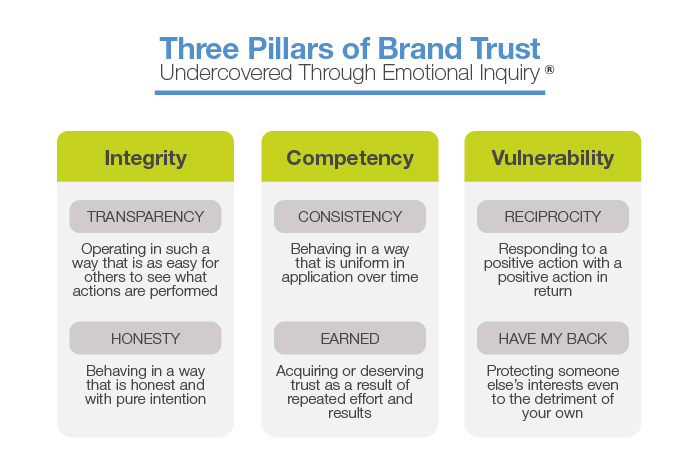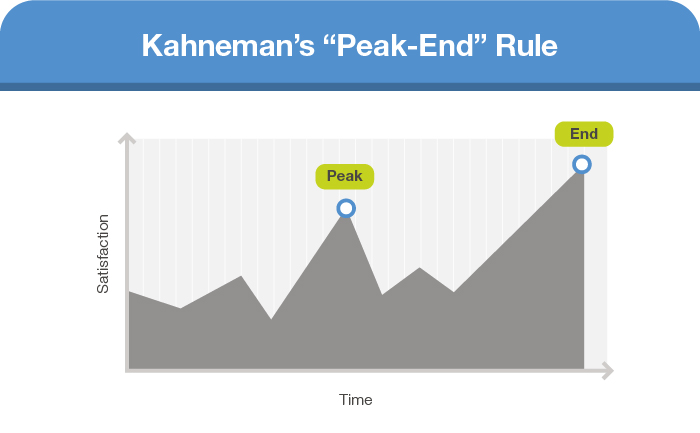Richard Thaler has news for you: Your brand probably isn’t selling to Spock.
A founding father of behavioral economics, Thaler has dedicated his career to documenting the irrational quirks of human psychology (to which the sensible Vulcan hero would be immune).
For too long, he argues, economists and executives alike have ignored the impact of these innately human traits when trying to understand consumer decisions.
He says the antidote is embracing the insights of social science research about the way people really behave. “For the last four decades I’ve been pleading with economists that we should be studying humans,” he told an interviewer last year.
Much like economists, marketers can’t afford to ignore human truths. At Brandtrust, we apply the learnings and techniques of social and behavioral sciences research to help brands better understand how their customers truly make choices. That means wading into the fascinating and complex space of the human mind at work.
Here are five of our most powerful marketing insights from nearly 20 years of work helping brands understand customer behavior:
5 Powerful Marketing Insights from Applied Social and Behavioral Sciences
#1 Every Decision Is Emotional
As consumers, we like to think of ourselves as precisely deliberative creatures, weighing prices and features with clear-eyed logic.
But research from the realms of psychology and behavioral economics proves nothing could be further from the truth. Indeed, emotional drivers account for the vast majority of our decisions, permitting us to make swift choices without the paralysis of extensive analysis.
Our research concludes that 95 percent of human thinking occurs in nonconscious mind, a murky region driven by 130 or more separate cognitive biases. These biases are powerfully emotional in their impacts: attraction and aversion, suspicion or trust.
Yet despite the unconscious mind’s dominance, we don’t experience its functions as discrete and perceptible thoughts. And because these emotional drivers can’t be rationally articulated, consumers’ explanations for their own behaviors are often retroactive justifications applied to irrational decisions.
This recognition is essential to our approach: We don’t ask customers what they want, because they can’t tell us. We also avoid flawed assumptions about rational consumer motives, which misrepresent the mind as a calculating organ of self-interest. We’re interested in real human truth, rather than appealing to Spock.
Accordingly, we root our research methodologies in the social and behavioral sciences. One approach we employ is Emotional Inquiry®, which applies social science techniques within an individual interview setting to understand the emotional drivers of our client’s target audience.
With this understanding of their customers’ “emotional brains” at work, marketers can move beyond dissecting their stated opinions – a deeply insufficient source. Our work reaches nonconscious realm, where human choice really happens.
Strategy: To truly appeal to customers, dig deeper than what they say.
Next step: Consider what you can learn through applied social and behavioral sciences to uncover your customers’ emotional drivers.
#2 Reciprocity Rules
If emotion reigns supreme in the realm of human choice, how can marketers enlist it in their efforts? In our hundreds of studies using our Emotional Inquiry® methodology, our team has identified three pillars of building brand trust: promise, competence, and integrity.
In other words, as one of our study participants said of a brand he trusted, “They’ve got my back.” He sees his relationship with the brand in emotional – and human – terms. But how can marketers achieve this connection with potential customers, before service even begins?
One key to unlocking such valuable trust is reciprocity: A brand extends value to to consumers first, with the hope that they’ll respond in kind. According to noted psychologist Robert Cialdini, dynamics of this kind trigger our innate instinct to reciprocate.
Regardless of personality or cultural context, humans experience real discomfort in the absence of reciprocation: It’s why we unfailingly reply when a stranger says hello, and why we are more inclined to donate to charities that send us small gifts. If a brand is willing to be vulnerable in demonstrating generosity first, many customers will feel eager to offer their business in return.
Marketers can offer any number of free benefits to potential customers, from useful informational content to no-obligation initial consultations. When these services are truly valuable to customers, reciprocation isn’t manipulation: It’s an authentic way to earn a trust.
Strategy: Be vulnerable enough to give value first, and reap the rewards of reciprocation.
Next step: Consider a small value-add you can provide, such as a free trial, or a no-obligation consultation. Then provide a reasonable call-to-action.
#3 Admitting Mistakes Earns Trust
Vulnerability extends beyond reciprocity, however: It also includes transparency, even and especially when the truth isn’t flattering. In our extensive research on how brands develop the trust of their customer, we find consumers anthropomorphize the brands they trust most, describing them in term typically reserved for people, such as “honest” or “trustworthy.”
But brands would do well to remember that to err is human, too. As such, admitting mistakes promptly and transparently can pay big dividends in developing consumer confidence.
One great example is Domino’s Pizza, whose ads explicitly embraced customers’ criticism of its quality. By acknowledging their past shortcomings and endeavoring to fix them, the brand has seen its share value rise from $14 in 2010 to $197 in 2017 – a 1307 percent increase.
If your brand’s service is flawed, admit it and address the issue openly. We don’t expect perfection from the people we trust, but we do appreciate their authenticity and honesty. Consumers apply this standard to the brands they trust, too.
Strategy: Own your brand’s mistakes. Honesty turns your errors into assets.
Next step: Communicate shortcomings with your brand’s audience and explain how you’ll make it right.
#4 Peak Moments Matter
Many brands seek to perfect every element of their engagement with customers, an aim so ambitious it’s usually doomed to failure.
Yet research overwhelmingly suggests that great customer experiences don’t depend on preternaturally flawless service. Rather, they revolve around the emotional impact of a few specific moments along their journey.
We derive this observation from Nobel Laureate Daniel Kahneman’s Peak-End rule, which correlates emotional memory with the most intense and final moments within a given experience. When we reflect on any interaction or occurrence, our recollection is characterized almost exclusively by these representative instants.
Apple applies this principle better than virtually any other brand, beautifully choreographing the aesthetics and emotions of peak experiences.
From the elegant packaging that greets you when you open a new iPhone to the warmth and ease of Genius bar consultations, the brand unfailingly capitalizes on opportunities for emotional impact. Accordingly, you’re less likely to recall more unpleasant elements, like how frightfully busy the Apple Store was or the presence of pre-loaded apps you can’t delete from your phone.
For marketers, these Peak-End experiences are particularly relevant as the fuel of reviews and word-of-mouth referrals. When asked to impart their experience with your brand to a friend, or submit their opinions online, which moments will dictate their description?
Identifying these moments of impact can present some difficulty: They exert their influence in the realm of emotional cognition, and thus resist articulation by consumers. For this reason, customer surveys will be of little use in unearthing peak experiences and may even point brands in the wrong direction altogether.
Because our methodologies are steeped in the social and behavioral sciences, they allow us to access these key moment along the customer journey, studying the instants of emotional truth that come to define the entire experience. Without these insights, brands may miss crucial opportunities to convert consumers to evangelists of their virtues.
Strategy: Identify peak moments along your customer’s path.
Next step: Once you’ve identified peak moments, consider the best opportunities for the brand to intervene in order to improve the communication and consumer experience at each of those points.
#5 Values Create Value
Over nearly two decades analyzing the factors that propel brand success, one theme recurs throughout our work: The central importance of purpose. In our comprehensive research on the formation of brand trust, nothing matters more than possessing a clear mission – and honoring that mission with action.
We use the terms “purpose” and “promise” when discussing this potent combination of a brand’s vision and values. A brand’s purpose is its reason for being, the guiding light for its every effort. It’s promise is the expression of that purpose to and for consumers.
Recent research suggests it’s a promise that resonates most with consumers, speaking to their emotional core. One study found 64 percent of customers who expressed loyalty to a given brand did so because they shared its values.
As we’ve noted time and again, this basis for emotional identification matters even more than practical performance. Trust, loyalty, and positive public perception all stem more from your promise than the precise minutia of your service.
If marketers seek to form meaningful connections with customers, they’ll need their brand to be full of meaning as well. But before you can express your mission by putting in into practice, you’ll need clarity and conviction about what your promise truly is.
Strategy: Identify your brand’s higher purpose, and let it guide your every action.
Next step: Create a guide for your employees to help them understand how your brand’s purpose can be reflected in their day-to-day work.
From Insight to Action
While every company seeks to better understand its market, each brand confronts a unique array of challenges and opportunities in reaching customers. Brandtrust was founded with this recognition in mind: As social scientists, we strive to equip brands with a better understanding of their customers’ true desires. Only then can they deliver on the wants and needs of their precise audience and cement their promise in the marketplace.
Our team employs a variety of research methodologies to access the unconscious drivers of consumer decisions. With these findings in hand, we help brands define a path to shared ideals, innovation and improved customer experience.
To learn more about how our approach can transform your brand and its marketing, explore our work with some of the world’s most powerful brands here.


